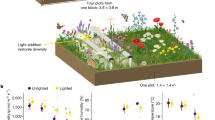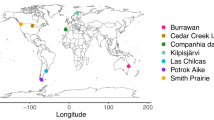Abstract
Human alterations to nutrient cycles1,2 and herbivore communities3,4,5,6,7 are affecting global biodiversity dramatically2. Ecological theory predicts these changes should be strongly counteractive: nutrient addition drives plant species loss through intensified competition for light, whereas herbivores prevent competitive exclusion by increasing ground-level light, particularly in productive systems8,9. Here we use experimental data spanning a globally relevant range of conditions to test the hypothesis that herbaceous plant species losses caused by eutrophication may be offset by increased light availability due to herbivory. This experiment, replicated in 40 grasslands on 6 continents, demonstrates that nutrients and herbivores can serve as counteracting forces to control local plant diversity through light limitation, independent of site productivity, soil nitrogen, herbivore type and climate. Nutrient addition consistently reduced local diversity through light limitation, and herbivory rescued diversity at sites where it alleviated light limitation. Thus, species loss from anthropogenic eutrophication can be ameliorated in grasslands where herbivory increases ground-level light.
This is a preview of subscription content, access via your institution
Access options
Subscribe to this journal
Receive 51 print issues and online access
$199.00 per year
only $3.90 per issue
Buy this article
- Purchase on Springer Link
- Instant access to full article PDF
Prices may be subject to local taxes which are calculated during checkout



Similar content being viewed by others
References
Foley, J. A., Monfreda, C., Ramankutty, N. & Zaks, D. Our share of the planetary pie. Proc. Natl Acad. Sci. USA 104, 12585–12586 (2007)
Rockström, J. et al. A safe operating space for humanity. Nature 461, 472–475 (2009)
Gibson, D. Grasses and Grassland Ecology (Oxford Univ. Press, 2009)
Neely, C., Bunning, S. & Wilkes, A. Review of Evidence on Drylands Pastoral Systems and Climate Change: Implications and Opportunities for Mitigation and Adaptation (Food and Agriculture Organization of the United Nations, 2009)
Foley, J. A. et al. Solutions for a cultivated planet. Nature 478, 337–342 (2011)
Millennium Ecosystem Assessment Panel. Ecosystems and Human Well-being: Synthesis (Island Press, 2005)
Wassenaar, T. et al. Projecting land use changes in the Neotropics: The geography of pasture expansion into forest. Glob. Environ. Change 17, 86–104 (2007)
Harpole, W. S. & Tilman, D. Grassland species loss resulting from reduced niche dimension. Nature 446, 791–793 (2007)
Holt, R. D., Grover, J. & Tilman, D. Simple rules for interspecific dominance in systems with exploitative and apparent competition. Am. Nat. 144, 741–771 (1994)
Díaz, S., Fargione, J., Chapin, F. S. & Tilman, D. Biodiversity loss threatens human well-being. PLoS Biol. 4, e277 (2006)
Hillebrand, H. et al. Consumer versus resource control of producer diversity depends on ecosystem type and producer community structure. Proc. Natl Acad. Sci. USA 104, 10904–10909 (2007)
Proulx, M. & Mazumder, A. Reversal of grazing impact on plant species richness in nutrient-poor vs. nutrient-rich ecosystems. Ecology 79, 2581–2592 (1998)
Worm, B., Lotze, H. K., Hillebrand, H. & Sommer, U. Consumer versus resource control of species diversity and ecosystem functioning. Nature 417, 848–851 (2002)
Olff, H. & Ritchie, M. E. Effects of herbivores on grassland plant diversity. Trends Ecol. Evol. 13, 261–265 (1998)
Milchunas, D. G. & Lauenroth, W. K. Quantitative effects of grazing on vegetation and soils over a global range of environments. Ecol. Monogr. 63, 327–366 (1993)
Huisman, J. & Weissing, F. J. Light-limited growth and competition for light in well-mixed aquatic environments: an elementary model. Ecology 75, 507–520 (1994)
Bakker, E. S., Ritchie, M. E., Olff, H., Milchunas, D. G. & Knops, J. M. H. Herbivore impact on grassland plant diversity depends on habitat productivity and herbivore size. Ecol. Lett. 9, 780–788 (2006)
Weissing, F. J. & Huisman, J. Growth and competition in a light gradient. J. Theor. Biol. 168, 323–336 (1994)
Dybzinski, R. & Tilman, D. Resource use patterns predict long-term outcomes of plant competition for nutrients and light. Am. Nat. 170, 305–318 (2007)
Hautier, Y., Niklaus, P. A. & Hector, A. Competition for light causes plant biodiversity loss after eutrophication. Science 324, 636–638 (2009)
Newman, E. I. Competition and diversity in herbaceous vegetation. Nature 244, 310 (1973)
Chesson, P. Mechanisms of maintenance of species diversity. Annu. Rev. Ecol. Syst. 31, 343–366 (2000)
Coley, P. D., Bryant, J. P. & Chapin, F. S. Resource availability and plant antiherbivore defense. Science 230, 895–899 (1985)
Strauss, S. Y., Rudgers, J. A., Lau, J. A. & Irwin, R. E. Direct and ecological costs of resistance to herbivory. Trends Ecol. Evol. 17, 278–285 (2002)
Lind, E. M. et al. Life-history constraints in grassland plant species: a growth-defence trade-off is the norm. Ecol. Lett. 16, 513–521 (2013)
Grime, J. P. & Pierce, S. The evolutionary strategies that shape ecosystems (Wiley-Blackwell, 2012)
Borer, E. T. et al. Finding generality in ecology: a model for globally distributed experiments. Methods Ecol. Evol. 5, 65–73 (2014)
De Schrijver, A. et al. Cumulative nitrogen input drives species loss in terrestrial ecosystems. Glob. Ecol. Biogeogr. 20, 803–816 (2011)
Crawley, M. J. Plant ecology (Blackwell Science, 1997)
Hijmans, R. J., Cameron, S. E., Parra, J. L., Jones, P. G. & Jarvis, A. Very high resolution interpolated climate surfaces for global land areas. Int. J. Climatol. 25, 1965–1978 (2005)
The Oak Ridge National Laboratory Distributed Active Archive Center. http://daac.ornl.gov/ (accessed (25 August 2011)
Grueber, C. E., Nakagawa, S., Laws, R. J. & Jamieson, I. G. Multimodel inference in ecology and evolution: challenges and solutions. J. Evol. Biol. 24, 699–711 (2011)
Acknowledgements
This work uses data from the Nutrient Network (http://nutnet.org) experiment, funded at the site scale by individual researchers. Coordination and data management are supported by funding to E. Borer and E. Seabloom from the NSF Research Coordination Network (NSF-DEB-1042132) and Long Term Ecological Research (NSF-DEB-1234162 to Cedar Creek LTER) programs and the UMN Institute on the Environment (DG-0001-13). The Minnesota Supercomputer Institute hosts project data. We are grateful to F. Isbell for suggestions that improved the manuscript. Any use of trade names is for descriptive purposes only and does not imply endorsement by the US Government.
Author information
Authors and Affiliations
Contributions
E.T.B., E.W.S., W.S.H. and E.M.L. are Nutrient Network coordinators. E.T.B., W.S.H., H.H. and D.S.G. developed and framed the research questions in this paper. All authors contributed data from this experiment. E.T.B. and E.W.S. analysed the data. D.S.G., W.S.H. and E.M.L. contributed to data analyses. E.T.B. wrote the paper with input from all authors. Supplementary Information Appendix S2 provides further information on author contributions.
Corresponding author
Ethics declarations
Competing interests
The authors declare no competing financial interests.
Extended data figures and tables
Extended Data Figure 1 Regression parameters for treatment effects.
a–c, All available data are shown for richness (a), total biomass (b) and ambient light reaching ground level (c). Error bars represent ±2 s.e.m. Treatment years and their associated sample sizes are shown in each panel. One- and two-year models represent greater spatial extent and replication, but reduced temporal extent compared to Fig. 2 in the main text. Four-year models represent longer temporal effects, but reduced spatial extent, particularly for light measurements. All models were fitted as in Extended Data Tables 2, 3, 4 and described in the Methods.
Extended Data Figure 2 Fertilization does not alter the relationship between ‘fence’ effects on light and diversity.
The log response ratio (LRR) model of the effect of fences (herbivore exclusion) on richness and light (year 3 data) demonstrates no additional effect of nutrient addition on the relationship shown in Fig. 3. The grey region indicates the 95% confidence interval around the regression. The effect of fences on ground-level light predicts changes in plot-scale species richness (P = 0.00254), whereas fertilization is not included in the final statistical model of this relationship (P > 0.05). Thus, the magnitude of the effect of grazers on richness is dependent on the magnitude of their effect on light regardless of whether a plot has been fertilized.
Supplementary information
Supplementary Information
This file contains Supplementary Appendices S1-S2. (PDF 159 kb)
Rights and permissions
About this article
Cite this article
Borer, E., Seabloom, E., Gruner, D. et al. Herbivores and nutrients control grassland plant diversity via light limitation. Nature 508, 517–520 (2014). https://doi.org/10.1038/nature13144
Received:
Accepted:
Published:
Issue Date:
DOI: https://doi.org/10.1038/nature13144
This article is cited by
-
Top-predator recovery abates geomorphic decline of a coastal ecosystem
Nature (2024)
-
Responses of plant diversity and soil microorganism diversity to nitrogen addition in the desert steppe, China
Journal of Arid Land (2024)
-
Assessing nutrient enrichment and grazing rest effects on grass establishment: implications for exotic and native species
Plant Ecology (2024)
-
Trade-offs between deer herbivory and nitrogen competition alter grassland forb composition
Oecologia (2024)
-
Grassland intensification effects cascade to alter multifunctionality of wetlands within metaecosystems
Nature Communications (2023)
Comments
By submitting a comment you agree to abide by our Terms and Community Guidelines. If you find something abusive or that does not comply with our terms or guidelines please flag it as inappropriate.



